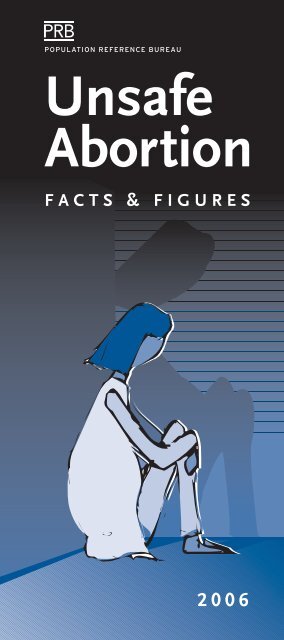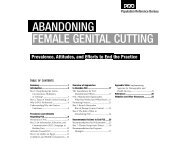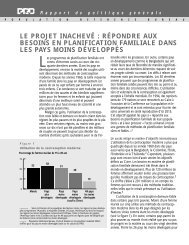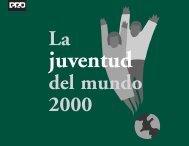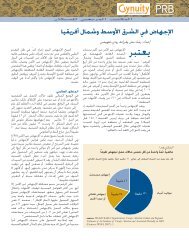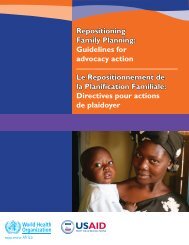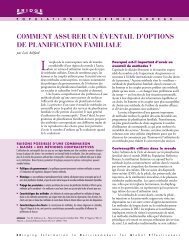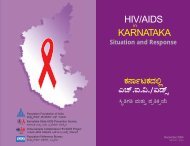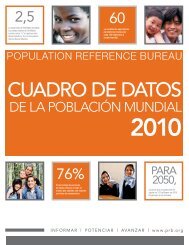Unsafe Abortion 2006 - Population Reference Bureau
Unsafe Abortion 2006 - Population Reference Bureau
Unsafe Abortion 2006 - Population Reference Bureau
You also want an ePaper? Increase the reach of your titles
YUMPU automatically turns print PDFs into web optimized ePapers that Google loves.
POPULATION REFERENCE BUREAU<br />
<strong>Unsafe</strong><br />
<strong>Abortion</strong><br />
<strong>Abortion</strong><br />
FACTS & FIGURES<br />
<strong>2006</strong>
Table of Contents<br />
Introduction ................................................................ 1<br />
Overview..................................................................... 3<br />
Incidence of <strong>Unsafe</strong> <strong>Abortion</strong> .................................... 5<br />
Maternal Health...........................................................9<br />
Safe <strong>Abortion</strong> ............................................................ 11<br />
<strong>Unsafe</strong> <strong>Abortion</strong>........................................................ 13<br />
Post-<strong>Abortion</strong> Care.....................................................17<br />
Unintended Pregnancies ...........................................19<br />
Unmet Need for Family Planning..............................23<br />
<strong>Abortion</strong> Laws and Policies .......................................25<br />
Glossary......................................................................29<br />
Appendix I:<br />
International Conventions.................................31<br />
Appendix II:<br />
How <strong>Unsafe</strong> <strong>Abortion</strong>s Are Counted................33<br />
Appendix III:<br />
About the Sources .............................................35<br />
Regional Data for Africa.............................................37<br />
Regional Data for Asia ...............................................45<br />
Regional Data for Latin America<br />
and the Caribbean .............................................53<br />
<strong>Population</strong> <strong>Reference</strong> <strong>Bureau</strong><br />
The <strong>Population</strong> <strong>Reference</strong> <strong>Bureau</strong> informs people around<br />
the world about population, health, and the environment,<br />
and empowers them to use that information to advance<br />
the well-being of current and future generations.<br />
Authors: Deborah Mesce, Manager, Media Programs, and<br />
Erin Sines, Policy Analyst, PRB.<br />
Editor: Ellen Carnevale, Director of Communications, PRB<br />
Design/Production: Michelle Corbett, Senior Graphic<br />
Designer, PRB<br />
Cover Illustration: Greg Berger, Greg Berger Design, Inc.<br />
©Copyright <strong>2006</strong>, <strong>Population</strong> <strong>Reference</strong> <strong>Bureau</strong>.<br />
All rights reserved.<br />
This publication is available in print and on PRB’s website.<br />
To become a PRB member or to order PRB materials,<br />
contact PRB, 1875 Connecticut Ave., NW, Suite 520,<br />
Washington, DC 20009-5728; Tel. (in the United States):<br />
800-877-9881; Fax: 202-328-3937; E-mail: popref@prb.org;<br />
Website: www.prb.org.<br />
For permission to reproduce portions from this publication,<br />
contact PRB at permissions@prb.org, or at the<br />
address above.
<strong>Unsafe</strong> <strong>Abortion</strong>:<br />
Facts & Figures<br />
Introduction<br />
<strong>Abortion</strong> is a sensitive and contentious issue with<br />
religious, moral, cultural, and political dimensions.<br />
It is also a public health concern in many parts of<br />
the world. More than one-quarter of the world’s<br />
people live in countries where the procedure is prohibited<br />
or permitted only to save the woman’s life.<br />
Yet, regardless of legal status, abortions still occur,<br />
and nearly half of them are performed by an<br />
unskilled practitioner or in less than sanitary conditions,<br />
or both.<br />
<strong>Abortion</strong>s performed under unsafe conditions<br />
claim the lives of tens of thousands of women<br />
around the world every year, leave many times that<br />
number with chronic and often irreversible health<br />
problems, and drain the resources of public health<br />
systems. Often, however, controversy overshadows<br />
the public health impact.<br />
This guide provides data and other information<br />
to help shed light on the public health aspects of<br />
unsafe abortion.<br />
<strong>Unsafe</strong> <strong>Abortion</strong><br />
1
Title<br />
2 <strong>Population</strong> <strong>Reference</strong> <strong>Bureau</strong>
Overview<br />
The World Health Organization (WHO) estimates<br />
that worldwide 211 million women become pregnant<br />
each year and that about two-thirds of them,<br />
or approximately 136 million, deliver live infants.<br />
The remaining one-third of pregnancies end in miscarriage,<br />
stillbirth, or induced abortion.<br />
Of the estimated 46 million induced abortions<br />
each year, nearly 19 million are performed in unsafe<br />
conditions and/or by unskilled providers and result<br />
in the deaths of an estimated 68,000 girls and<br />
women. This represents about 13 percent of all<br />
pregnancy-related deaths. Almost all unsafe abortions<br />
take place in developing countries, and this is<br />
where 99 percent of abortion-related deaths occur.<br />
Overview<br />
<strong>Unsafe</strong> <strong>Abortion</strong><br />
WHO defines an unsafe abortion as “a procedure<br />
for terminating an un-wanted pregnancy either by<br />
persons lacking the necessary skills or in an environment<br />
lacking the minimal medical standards,<br />
or both.” When abortion<br />
is performed by qualified<br />
people using correct<br />
techniques in sanitary<br />
conditions, it is very safe.<br />
The death rate from legal<br />
induced abortion in the<br />
United States, for example,<br />
is less than one per<br />
100,000 procedures.<br />
15%<br />
Miscarriages &<br />
stillbirths<br />
22%<br />
Induced<br />
abortions<br />
63%<br />
Live births<br />
Worldwide, nearly one in 10 pregnancies ends<br />
in unsafe abortion. But this is a global estimate,<br />
combining countries where abortion is safe and<br />
legal with those where it is restricted and often<br />
unsafe. In low-income countries, women have<br />
an average of one unsafe abortion during their<br />
reproductive lives.<br />
Sources:<br />
World Health Organization (WHO), World Health Report 2005.<br />
WHO, <strong>Unsafe</strong> <strong>Abortion</strong>: Global and Regional Estimates of the<br />
Incidence of <strong>Unsafe</strong> <strong>Abortion</strong> and Associated Mortality in 2000,<br />
4th ed. (2004).<br />
U.S. Centers for Disease Control and Prevention, Mortality and<br />
Morbidity Weekly Review, Surveillance Summaries (2003).<br />
Iqbal Shah and Elisabeth Ahman, “Age Patterns of <strong>Unsafe</strong><br />
<strong>Abortion</strong> in Developing Country Regions,” Reproductive Health<br />
Matters 12, no. 24 (supplement, 2004).<br />
<strong>Unsafe</strong> <strong>Abortion</strong><br />
3
4 <strong>Population</strong> <strong>Reference</strong> <strong>Bureau</strong>
Incidence of <strong>Unsafe</strong> <strong>Abortion</strong><br />
• Worldwide, one in five pregnancies (22 percent)<br />
ends in abortion, and one in 10 pregnancies<br />
ends in unsafe abortion. (See Appendix II on<br />
how unsafe abortions are counted.)<br />
• An estimated 46 million abortions are performed<br />
each year; 19 million of them are outside the<br />
legal system and considered unsafe because they<br />
are performed by people who lack the necessary<br />
skills or in places that do not meet minimal<br />
medical standards, or both.<br />
• An estimated 529,000 girls and women die from<br />
pregnancy-related causes each year, almost all of<br />
them in the developing world. About 68,000 of<br />
these deaths are due to unsafe abortion.<br />
• Globally, abortion-related deaths account for<br />
13 percent of all pregnancy-related deaths, but<br />
the percentage can be much higher at country<br />
levels. A 2000 study estimated that unsafe abortions<br />
were responsible for nearly one-third of<br />
maternal deaths in West Africa, and WHO<br />
reports that in the countries of sub-Saharan<br />
Africa unsafe abortions are responsible for as<br />
much as 50 percent of maternal deaths.<br />
Incidence of <strong>Unsafe</strong> <strong>Abortion</strong><br />
• Women in developed and developing regions<br />
of the world turn to abortion at similar rates;<br />
annually, 34 abortions are performed per 1,000<br />
women in developing countries, compared with<br />
39 per 1,000 women in developed countries.<br />
• Two in five unsafe abortions occur among<br />
women under age 25, and about one in seven<br />
women who have unsafe abortions is under 20.<br />
• In Africa, about one-quarter of the unsafe abortions<br />
are among teenagers (ages 15 to 19), a<br />
higher proportion than in any other world region.<br />
Sources:<br />
WHO, <strong>Unsafe</strong> <strong>Abortion</strong>: Global and Regional Estimates of the<br />
Incidence of <strong>Unsafe</strong> <strong>Abortion</strong> and Associated Mortality in 2000,<br />
4th ed. (2004).<br />
WHO, Communicating Family Planning in Reproductive Health<br />
(1997).<br />
Alan Guttmacher Institute, Sharing Responsibility: Women,<br />
Society and <strong>Abortion</strong> Worldwide (1999).<br />
continued...<br />
<strong>Unsafe</strong> <strong>Abortion</strong><br />
5
Incidence of <strong>Unsafe</strong> <strong>Abortion</strong><br />
Iqbal Shah and Elisabeth Ahman, “Age Patterns of <strong>Unsafe</strong><br />
<strong>Abortion</strong> in Developing Country Regions,” Reproductive Health<br />
Matters 12, no. 24 (supplement, 2004).<br />
Patrick Thonneau et al., “<strong>Abortion</strong> and Maternal Mortality in<br />
Africa,” New England Journal of Medicine 347, no. 24 (2002).<br />
Estimates of Annual Incidence of <strong>Unsafe</strong> <strong>Abortion</strong>s<br />
and Maternal Deaths Due to <strong>Unsafe</strong> <strong>Abortion</strong>,<br />
Around Year 2000<br />
Number<br />
of maternal<br />
Number deaths due % of all<br />
of unsafe to unsafe maternal<br />
abortions abortion deaths<br />
World 19 million 67,900 13<br />
Developed countries 500,000 300 14<br />
Developing countries 18.4 million 67,500 13<br />
Africa 4.2 million 29,800 12<br />
Eastern Africa 1.7 million 15,300 14<br />
Middle Africa 400,000 4,900 10<br />
Northern Africa 700,000 600 6<br />
Southern Africa 200,000 400 11<br />
Western Africa 1.2 million 8,700 10<br />
Asia 10.5 million 34,000 13<br />
Eastern Asia<br />
(excluding Japan) negligible negligible negligible<br />
South Central Asia 7.2 million 28,700 14<br />
Southeastern Asia 2.7 million 4,700 19<br />
Western Asia 500,000 600 6<br />
Europe 500,000 300 20<br />
Eastern Europe 400,000 300 26<br />
Northern Europe 10,000 negligible 4<br />
Southern Europe 100,000
Percent of <strong>Unsafe</strong> <strong>Abortion</strong>s by Age Group,<br />
Around Year 2000<br />
33<br />
26<br />
28<br />
29<br />
25<br />
14<br />
26 25<br />
19<br />
17<br />
20<br />
22<br />
22<br />
20<br />
14<br />
16 17<br />
12 11<br />
8<br />
Developing<br />
Countries<br />
Africa Asia* Latin America<br />
& Caribbean<br />
Ages 15-19<br />
Ages 20-24<br />
Ages 25-29<br />
Ages 30-34<br />
Ages 35-44<br />
* Excludes Eastern Asia (China, North Korea, South Korea,<br />
and Mongolia).<br />
Note: Figures may not add to 100 due to rounding.<br />
Source: Iqbal Shah and Elisabeth Ahman, “Age Patterns of<br />
<strong>Unsafe</strong> <strong>Abortion</strong> in Developing Country Regions,” Reproductive<br />
Health Matters 12, no. 24 (supplement, 2004).<br />
The ages at which women have unsafe abortions<br />
differ markedly across regions.<br />
• Nearly 60 percent of women in sub-Saharan<br />
Africa who have unsafe abortions are younger<br />
than 25, and 25 percent are still in their teens.<br />
• In Asia, 70 percent of unsafe abortions are among<br />
women 25 and older; many of them already have<br />
children and want to limit family size.<br />
• In Latin America and the Caribbean, more than<br />
half of unsafe abortions occur among women<br />
who are in their 20s, suggesting that women in<br />
this region use unsafe abortion to space births<br />
and limit family size.<br />
<strong>Unsafe</strong> <strong>Abortion</strong> 7
Title<br />
8 <strong>Population</strong> <strong>Reference</strong> <strong>Bureau</strong>
Maternal Health<br />
• An estimated 529,000 girls and women die of<br />
pregnancy-related causes each year, about one<br />
every minute, and many times that number suffer<br />
long-term injuries and disabilities.<br />
• 99 percent of all maternal deaths occur in the<br />
developing world.<br />
• Of the 529,000 maternal deaths in 2000, most<br />
of them were equally divided between Asia<br />
(253,000) and Africa (251,000). About 4 percent<br />
of maternal deaths were in Latin America and<br />
the Caribbean (22,000), and less than 1 percent<br />
(2,500) were in the developed countries.<br />
• Pregnancy-related deaths are often expressed<br />
as a ratio of deaths per 100,000 live births,<br />
allowing for comparison among countries<br />
and regions. The global ratio is 400 maternal<br />
deaths per 100,000 live births, but regional<br />
ratios range from 920 per 100,000 live births<br />
in sub-Saharan Africa to 16 per 100,000 live<br />
births in North America.<br />
• Direct causes of pregnancy-related deaths<br />
worldwide are:<br />
Severe bleeding 25%<br />
Infection 15%<br />
<strong>Unsafe</strong> abortion 13%<br />
Hypertensive disorders 12%<br />
Obstructed labor 8%<br />
Other 8%<br />
Maternal Health<br />
• 20 percent of pregnancy-related deaths are due<br />
to indirect causes, including diseases such as<br />
malaria, anemia, HIV/AIDS, and cardiovascular<br />
disease.<br />
• A woman in sub-Saharan Africa has a 1 in 16<br />
chance of dying from a pregnancy-related cause,<br />
compared with a woman in North America,<br />
whose risk is 1 in 2,566.<br />
• Complications of pregnancy and childbirth are<br />
a leading cause of death and disability among<br />
women of reproductive age in most developing<br />
countries. For teenagers, these are the leading<br />
cause of death.<br />
continued...<br />
<strong>Unsafe</strong> <strong>Abortion</strong><br />
9
Maternal Health<br />
• Teenage girls are twice as likely as women over<br />
20 to die of complications from pregnancy and<br />
childbirth. Girls ages 10 to 14 are five times as<br />
likely as women ages 20 to 24 to die of these<br />
complications.<br />
Sources:<br />
WHO, UNICEF, and UNFPA, Maternal Mortality in 2000:<br />
Estimates Developed by WHO, UNICEF and UNFPA (2004).<br />
<strong>Population</strong> <strong>Reference</strong> <strong>Bureau</strong>, Women of Our World 2005.<br />
WHO, World Health Report 2005.<br />
UNFPA, State of World <strong>Population</strong> 2005.<br />
Save the Children, State of the World’s Mothers 2004.<br />
Maternal Mortality<br />
Maternal<br />
mortality<br />
ratio, 2000*<br />
Lifetime chance<br />
of dying from<br />
maternal causes**<br />
World 400 1 in 74<br />
Developed countries 20 1 in 2,800<br />
Developing countries 440 1 in 61<br />
Africa 830 1 in 20<br />
Northern Africa<br />
(including Sudan) 230 1 in 210<br />
Sub-Saharan Africa 920 1 in 16<br />
Latin America/Caribbean 190 1 in 160<br />
North America 16 1 in 2,566<br />
Europe 24 1 in 2,400<br />
Asia 330 1 in 94<br />
Eastern Asia 53 1 in 840<br />
South Central Asia 520 1 in 46<br />
Southeastern Asia 210 1 in 140<br />
Western Asia 190 1 in 120<br />
Oceania 110 1 in 316<br />
* Maternal deaths per 100,000 live births.<br />
** Lifetime risk reflects a country or region’s maternal mortality<br />
as well as its fertility rate. Risk is greater for women in areas of<br />
high fertility because they are pregnant more often and therefore<br />
face the risks of pregnancy more often than women in<br />
areas of low fertility.<br />
Source: <strong>Population</strong> <strong>Reference</strong> <strong>Bureau</strong>, Women of Our World<br />
2005.<br />
10 <strong>Population</strong> <strong>Reference</strong> <strong>Bureau</strong>
Safe <strong>Abortion</strong><br />
<strong>Abortion</strong> is safest when performed early in a pregnancy.<br />
Safe methods of abortion used during the first<br />
trimester (12 weeks) of pregnancy are vacuum aspiration,<br />
dilation and curettage, and medication abortion.<br />
(The length of a pregnancy is measured from the first<br />
day of a woman’s last menstrual period.) In some<br />
countries, women within a few weeks of a missed<br />
menstrual period can undergo a procedure called<br />
menstrual regulation, which uses vacuum aspiration<br />
or medication to induce menstruation; the procedure<br />
is often performed without testing for pregnancy.<br />
Vacuum aspiration<br />
• The procedure removes the contents of the uterus<br />
by applying suction through a tube, called a cannula,<br />
inserted through the cervix into the uterus.<br />
• Either an electric pump or a manual aspirator is<br />
used to suction the uterine contents; with either<br />
method it is usually performed on an outpatient<br />
basis.<br />
• The procedure is widely used through 12 weeks<br />
of pregnancy, and the more-experienced providers<br />
can use it safely through 15 weeks.<br />
• As with any abortion procedure, side effects<br />
include abdominal cramping or pain and bleeding.<br />
• The procedure is also known as suction abortion,<br />
vacuum curettage, suction curettage, and minisuction.<br />
Dilation and curettage (D&C)<br />
• This method uses mechanical dilators to open the<br />
cervix and metal instruments called curettes to<br />
scrape the uterine walls.<br />
• The procedure is typically performed under heavy<br />
sedation or general anesthesia and has a higher<br />
risk of complications (bleeding, infection, and perforation)<br />
than other methods.<br />
• WHO advises that this method be used only when<br />
vacuum aspiration or medical methods of abortion<br />
are not available.<br />
• It is also known as sharp curettage and surgical<br />
abortion.<br />
continued...<br />
Safe <strong>Abortion</strong><br />
<strong>Unsafe</strong> <strong>Abortion</strong><br />
11
Safe <strong>Abortion</strong><br />
Medication abortion<br />
• This method uses one or more drugs, most<br />
commonly mifepristone (known as RU486)<br />
and misoprostol (also known as Cytotec),<br />
to expel the contents of the uterus.<br />
• The procedure usually requires at least two<br />
outpatient visits, and the abortion is almost<br />
always complete within a week. In 2 percent to<br />
5 percent of cases, the abortion is incomplete<br />
and vacuum aspiration or D&C is required.<br />
• Mifepristone with misoprostol is used through<br />
nine weeks of pregnancy, and its safety and<br />
effectiveness between nine and 12 weeks is<br />
being studied.<br />
• Most women experience abdominal cramping<br />
and bleeding. Side effects include vomiting,<br />
nausea, diarrhea, chills, and fever.<br />
• Misoprostol is sometimes used alone, usually<br />
where mifepristone is not available, but it appears<br />
to be less effective than the combination.<br />
• Other terms for this procedure are medical,<br />
pharmaceutical, or pharmacological abortion;<br />
RU486; and the abortion pill.<br />
For pregnancies of more than 12 completed<br />
weeks since the woman’s last menstrual period, the<br />
two most widely used abortion methods are dilation<br />
and evacuation (D&E) and medication abortion.<br />
Dilation and evacuation (D&E) involves dilating<br />
the cervix and using a combination of suction<br />
and instruments to remove contents of the uterus.<br />
Medication abortion uses one or more pharmaceuticals<br />
usually in multiple doses to cause uterine contractions<br />
that expel the pregnancy.<br />
Source: WHO, Safe <strong>Abortion</strong>: Technical and Policy Guidance for<br />
Health Systems (2003).<br />
12 <strong>Population</strong> <strong>Reference</strong> <strong>Bureau</strong>
<strong>Unsafe</strong> <strong>Abortion</strong><br />
The World Health Organization defines an unsafe<br />
abortion as “a procedure for terminating an<br />
unwanted pregnancy either by persons lacking<br />
the necessary skills or in an environment lacking<br />
the minimal medical standards, or both.”<br />
Where abortion is restricted by law, girls and<br />
women who can afford to pay often can find a<br />
private physician, or sometimes a nurse or midwife,<br />
willing to perform a safe abortion. Women who<br />
cannot afford or cannot access these services may<br />
try to abort the pregnancy themselves, or they may<br />
turn to unskilled practitioners (including traditional<br />
or religious healers, homeopaths, and herbalists)<br />
who use a variety of methods.<br />
<strong>Unsafe</strong> Tab <strong>Abortion</strong> 1<br />
<strong>Unsafe</strong> methods include:<br />
• Swallowing large doses of drugs, such as antimalarials<br />
or oral contraceptives (birth control<br />
pills).<br />
• Inserting a sharp object into the uterus.<br />
• Drinking or flushing the vagina with caustic<br />
liquids such as bleach.<br />
• Physical abuse such as jumping or falling from<br />
high places, vigorous dancing, or sustained and<br />
vigorous sexual intercourse over long periods.<br />
• Prolonged and hard massage to manipulate the<br />
uterus, or repeated blows to the stomach.<br />
Not all illegal abortions are unsafe. For example,<br />
in some unsanctioned clinics in India, trained<br />
professionals perform abortions that may be<br />
medically safe but are technically illegal due to<br />
the unregistered status of the clinic.<br />
Increasingly, women around the world are<br />
purchasing medications, including Cytotec<br />
(misoprostol), on the black market and from<br />
other insecure and unreliable sources to induce<br />
abortions. These medications are unregulated<br />
and may be labeled incorrectly. Without the benefit<br />
of medical advice or attention, women may be<br />
unaware of how far along their pregnancies are<br />
and may ingest these medications well after is it<br />
safe to induce a medication abortion.<br />
continued...<br />
<strong>Unsafe</strong> <strong>Abortion</strong><br />
13
<strong>Unsafe</strong> <strong>Abortion</strong><br />
WHO estimates that between 10 percent and<br />
50 percent of the girls and women who have unsafe<br />
abortions suffer complications that need medical<br />
attention. If left untreated, these complications can<br />
be fatal. Spontaneous abortion or miscarriage can<br />
result in the same serious complications.<br />
Here are some of the serious conditions that<br />
require prompt medical attention:<br />
Incomplete abortion occurs when some tissue<br />
remains in the uterus.<br />
• Symptoms include abdominal pain; vaginal<br />
bleeding; and a soft, enlarged uterus.<br />
• Treatment involves removing the remaining<br />
tissue in the uterus with vacuum aspiration or,<br />
if that is not available, with dilation and curettage.<br />
(See Safe <strong>Abortion</strong>.)<br />
Infection of uterine tissue can result from use of<br />
contaminated instruments or when tissue remains<br />
in the uterus.<br />
• Symptoms include those of incomplete abortion<br />
as well as fever, chills, and foul-smelling vaginal<br />
discharge and uterine tenderness. Most often,<br />
symptoms appear two to three days after the<br />
abortion.<br />
• Treatment involves antibiotics and vacuum<br />
aspiration if needed to remove the remaining<br />
tissue in the uterus.<br />
Heavy bleeding results when an incomplete abortion<br />
is not treated or from some abortion techniques<br />
such as dilation and curettage (see Safe <strong>Abortion</strong>)<br />
or insertion of sticks or other objects into the cervix.<br />
• Heavy bleeding also can be triggered by toxic<br />
reactions caused by herbs, drugs, or chemicals<br />
that are swallowed or placed in the vagina.<br />
• Treatment may require removing remaining<br />
tissue in the uterus and administration of drugs<br />
to stop the bleeding, intravenous fluid replacement,<br />
and, in severe cases, blood transfusion<br />
or surgery.<br />
14 <strong>Population</strong> <strong>Reference</strong> <strong>Bureau</strong>
Uterine perforation can occur when a sharp object<br />
or instrument is inserted into the uterus.<br />
• Other organs also can be injured, including the<br />
cervix, ovaries, bowel, bladder, and rectum.<br />
• Observation and antibiotics may be all that is<br />
needed as treatment, but in more severe cases,<br />
surgery may be needed to repair damage to<br />
bowel, blood vessels, or other organs.<br />
Untreated, these complications can cause<br />
disabilities and chronic conditions that include:<br />
chronic pelvic pain; pelvic inflammatory disease,<br />
an infection of the reproductive organs (see<br />
Glossary); and infertility.<br />
Sources:<br />
WHO, World Health Report 2005.<br />
Alan Guttmacher Institute, Sharing Responsibility: Women,<br />
Society and <strong>Abortion</strong> Worldwide (1999).<br />
WHO, Safe <strong>Abortion</strong>: Technical and Policy Guidelines for Health<br />
Systems (2003).<br />
<strong>Population</strong> <strong>Reference</strong> <strong>Bureau</strong>, Hidden Suffering: Disabilities<br />
from Pregnancy and Childbirth in Less Developed Countries<br />
(2002).<br />
<strong>Population</strong> Information Program, Center for Communication<br />
Programs, The Johns Hopkins School of Public Health,<br />
<strong>Population</strong> Reports 25, no. 1 (1997).<br />
WHO, Division of Family Health, <strong>Abortion</strong>. A Tabulation of<br />
Available Data on the Frequency and Mortality of <strong>Unsafe</strong><br />
<strong>Abortion</strong>, 2d ed. (1993).<br />
<strong>Unsafe</strong> <strong>Abortion</strong> 15
16 <strong>Population</strong> <strong>Reference</strong> <strong>Bureau</strong>
Post-<strong>Abortion</strong> Care<br />
• In some areas of the developing world, as many<br />
as half of the admissions to hospital gynecological<br />
wards are women needing treatment after<br />
unsafe abortions.<br />
• Women who seek medical treatment after an<br />
unsafe abortion may require extended hospital<br />
stays, ranging from several days to several<br />
weeks. This consumes hospital resources,<br />
including personnel time, bed space, medications,<br />
and blood supply.<br />
• Studies show that hospitals in some developing<br />
countries spend as much as 50 percent of their<br />
budgets to treat complications of unsafe abortion.<br />
International health organizations generally recognize<br />
post-abortion care to include:<br />
• Emergency treatment for complications of<br />
abortion or miscarriage.<br />
Post-<strong>Abortion</strong> Care<br />
• Counseling to identify and respond to women’s<br />
emotional and physical health needs and other<br />
concerns.<br />
• Contraceptive and family planning services to<br />
help women prevent an unwanted pregnancy or<br />
unsafe abortion or to practice birth spacing.<br />
• Management of sexually transmitted infections.<br />
• Reproductive and other health services that are<br />
provided on-site or through referrals to other<br />
accessible facilities.<br />
The 1994 International Conference on <strong>Population</strong><br />
and Development, in its consensus Programme<br />
of Action, called for all women to have access to<br />
treatment for abortion-related complications and<br />
post-abortion counseling, education, and family<br />
planning services, regardless of the legal status<br />
of abortion. (See Appendix I.)<br />
Sources:<br />
UNFPA, State of World <strong>Population</strong> 2004.<br />
WHO, Communicating Family Planning in Reproductive Health<br />
(1997).<br />
Postabortion Care Consortium Community Task Force,<br />
Postabortion Care Consortium, Essential Elements of<br />
Postabortion Care: An Expanded and Updated Model (2002).<br />
<strong>Unsafe</strong> <strong>Abortion</strong><br />
17
18 <strong>Population</strong> <strong>Reference</strong> <strong>Bureau</strong>
Unintended Pregnancies<br />
• Around 80 million pregnancies each year are<br />
unintended and more than one-half result in<br />
induced abortion.<br />
• About one-third (26.5 million) of unintended<br />
pregnancies each year result from incorrect<br />
use or failure of contraceptives.<br />
Unintended Pregnancies by Region,<br />
1995–2000<br />
Region<br />
% of unintended<br />
pregnancies<br />
Africa 18<br />
Latin America/Caribbean 37<br />
North America 28<br />
Near East 26<br />
Europe/Central Asia 41<br />
Asia 27<br />
Developed Pacific 29<br />
Note: Percentage of women answering “no” to a Demographic<br />
and Health Survey question asking whether their last birth was<br />
wanted; it does not include mistimed births. (See Appendix III.)<br />
Source: Global Health Council, Promises to Keep (2002).<br />
• No contraceptive method is 100 percent effective.<br />
Even with perfect use, some contraceptives fail.<br />
According to research based on U.S. women<br />
using a single contraceptive method for one<br />
year, male condoms used correctly and consistently<br />
will fail 2 percent of the time; with more<br />
typical use, which is not always correct or consistent,<br />
the failure rate of male condoms rises to<br />
15 percent.<br />
Unintended Pregnancies<br />
• The failure rate of oral contraceptives is less<br />
than 1 percent with perfect use, but the rate<br />
rises to 8 percent with less-than-perfect use.<br />
• 61 percent of the world’s women who are<br />
married or are in an informal union use some<br />
form of contraception.<br />
• Contraceptive use is lowest in sub-Saharan<br />
Africa, where 22 percent use some form of contraception<br />
and 15 percent use modern methods.<br />
continued...<br />
<strong>Unsafe</strong> <strong>Abortion</strong><br />
19
Unintended Pregnancies<br />
• Modern methods include hormonal methods<br />
such as birth control pills, implants like<br />
Norplant, and injectables like Depo-Provera;<br />
female and male sterilization; intrauterine device<br />
(IUD); barrier methods such as male or female<br />
condom, diaphragm, cervical cap, and contraceptive<br />
sponge; and chemical spermicides in the<br />
form of jelly or foam.<br />
• Traditional methods include periodic abstinence<br />
(also known as rhythm or calendar method)<br />
and withdrawal.<br />
Sources:<br />
WHO, <strong>Unsafe</strong> <strong>Abortion</strong>: Global and Regional Estimates of the<br />
Incidence of <strong>Unsafe</strong> <strong>Abortion</strong> and Associated Mortality in 2000,<br />
4th ed. (2004).<br />
WHO, World Health Report 2005.<br />
Contraceptive Technology: Eighteenth Revised Edition (2004).<br />
<strong>Population</strong> <strong>Reference</strong> <strong>Bureau</strong>, <strong>2006</strong> World <strong>Population</strong> Data<br />
Sheet.<br />
Contraceptive Efficacy Rates<br />
Percent of women experiencing an unintended pregnancy<br />
within the first year of use (United States)*<br />
Method Typical use Perfect use**<br />
No method 85 85<br />
Spermicides 29 18<br />
Withdrawal 27 4<br />
Periodic abstinence 25 1 to 9***<br />
Diaphragm 16 6<br />
Female condom 21 5<br />
Male condom 15 2<br />
Pill 8
Emergency contraception<br />
• Emergency contraceptives (EC) are back-up<br />
methods of preventing pregnancy after unprotected<br />
sexual intercourse. They do not terminate<br />
existing pregnancies, and they do not protect<br />
against sexually transmitted diseases.<br />
• EC in pill form—also called the “morning-after<br />
pill”—can reduce the risk of pregnancy by<br />
75 percent or more if taken within 72 hours<br />
(three days) of unprotected sexual intercourse.<br />
It is more effective the sooner after sex it<br />
is taken.<br />
• EC pills contain the same medicine used in birth<br />
control pills but in higher doses. They work by<br />
stopping or delaying the release of an egg from<br />
the ovary, and they also may prevent sperm from<br />
fertilizing an egg or a fertilized egg from attaching<br />
to the uterus.<br />
• If a woman is pregnant (a fertilized egg is<br />
implanted in her uterus), EC pills will not cause<br />
an abortion and the pregnancy will continue.<br />
• Insertion of an IUD within seven days after<br />
unprotected sex can reduce the risk of pregnancy<br />
by 99 percent.<br />
• EC is intended to be used after sexual intercourse<br />
when no contraceptive has been used,<br />
a contraceptive method has failed or been used<br />
incorrectly, or sex was forced.<br />
• EC is not intended to be used in place of regular,<br />
ongoing contraception.<br />
Sources:<br />
International Consortium for Emergency Contraception.<br />
U.S. Food and Drug Administration.<br />
continued...<br />
<strong>Unsafe</strong> <strong>Abortion</strong> 21
Unintended Pregnancies<br />
Global and Regional Estimates<br />
of Contraception Rates<br />
Lifetime<br />
births per<br />
% married % married woman<br />
women using women using (total<br />
any method of modern method fertility<br />
contraception of contraception rate)<br />
World 61 54 2.7<br />
More developed 68 58 1.6<br />
Less developed 59 53 2.9<br />
Africa 28 22 5.1<br />
Northern Africa 49 44 3.2<br />
Sub-Saharan Africa 21 14 5.6<br />
West Africa 14 9 5.8<br />
East Africa 24 19 5.5<br />
Middle Africa 26 6 6.3<br />
Southern Africa 54 53 2.9<br />
North America 73 69 2.0<br />
Latin America/<br />
Caribbean 71 63 2.5<br />
Asia 65 59 2.4<br />
Western Asia 51 32 3.4<br />
South-Central Asia 51 43 3.1<br />
Southeast Asia 60 52 2.5<br />
East Asia 84 82 1.6<br />
Europe 68 53 1.4<br />
Northern Europe 82 76 1.7<br />
Western Europe 74 70 1.6<br />
Eastern Europe 64 42 1.3<br />
Southern Europe 59 43 1.4<br />
Oceania 72 63 2.1<br />
Source: <strong>Population</strong> <strong>Reference</strong> <strong>Bureau</strong>, <strong>2006</strong> World <strong>Population</strong><br />
Data Sheet.<br />
22 <strong>Population</strong> <strong>Reference</strong> <strong>Bureau</strong>
Unmet Need for Family Planning<br />
In developing countries, about one in six married<br />
women faces an “unmet need” for family planning—they<br />
prefer not to become pregnant but are<br />
not using any form of contraception.<br />
Unmet need is measured with the Demographic<br />
and Health Survey (DHS) and other large, national<br />
household surveys, in which married women ages<br />
15 to 49 are asked about their childbearing preferences<br />
and their use of contraceptives. (It should be<br />
noted that these surveys often do not measure the<br />
contraceptive needs of unmarried women or<br />
women who are not satisfied with the contraceptive<br />
method they are using.)<br />
According to surveys completed in developing<br />
countries in 1999 and 2000, women who said they<br />
did not want to become pregnant cited various<br />
reasons for not using contraception. The most<br />
common was that they didn’t think they could get<br />
pregnant because they were having sex infrequently,<br />
were in menopause, or were breastfeeding. Other<br />
reasons were:<br />
• Opposition to family planning, by the woman,<br />
her husband, or others.<br />
• Problems with contraceptive methods, including<br />
side effects and health concerns, and, to a lesser<br />
extent, cost and access.<br />
• Lack of knowledge about methods or where they<br />
could get them.<br />
Reducing unmet need can help to reduce unintended<br />
pregnancies, which lead to abortions and<br />
unwanted births. Ways in which unmet need can<br />
be addressed include:<br />
• Informing women of the benefits and possible<br />
side effects of available contraceptive methods<br />
so they can choose the method most appropriate<br />
for them.<br />
• Informing women of their chances of becoming<br />
pregnant after an abortion or childbirth, during<br />
breastfeeding, or when they are approaching<br />
menopause, and counseling them on family<br />
planning methods that might be appropriate<br />
for them.<br />
Unmet Need for Family Planning<br />
continued...<br />
<strong>Unsafe</strong> <strong>Abortion</strong><br />
23
Unmet Need for Family Planning<br />
• Improving communication between health care<br />
providers and their clients.<br />
• Providing periodic follow-up counseling to<br />
reduce the number of women who don’t want<br />
to become pregnant but who stop using contraception.<br />
• Encouraging men to discuss family planning<br />
with their wives.<br />
Source: <strong>Population</strong> <strong>Reference</strong> <strong>Bureau</strong>, Unmet Need for Family<br />
Planning (2003).<br />
24 <strong>Population</strong> <strong>Reference</strong> <strong>Bureau</strong>
<strong>Abortion</strong> Laws and Policies<br />
The legal status of abortion is one factor that determines<br />
the extent to which the procedure is safe,<br />
affordable, and accessible. In countries where abortion<br />
is legal, abortions are more likely to be performed<br />
by trained health professionals, be more<br />
available, and cost less. In these countries, maternal<br />
deaths and injuries tend to be lower.<br />
In some countries, written laws or policies on<br />
abortion do not necessarily reflect what is actually<br />
practiced. Some countries may have a specific law<br />
prohibiting abortion, but in practice government<br />
officials, the courts, and health care providers interpret<br />
the law more broadly, or interpretation can be<br />
unpredictable and enforcement of laws can vary.<br />
<strong>Abortion</strong> laws generally fall into five categories,<br />
from most to least restrictive:<br />
<strong>Abortion</strong> Laws and Policies<br />
• To save the life of the pregnant woman.<br />
• To preserve her physical health.<br />
• To protect her mental health.<br />
• On socioeconomic grounds.<br />
• For any reason.<br />
In addition, many countries allow abortion in<br />
cases of rape, incest, and fetal impairment.<br />
Countries also may:<br />
• Limit the length of a pregnancy during which<br />
an abortion can be performed.<br />
• Require the husband’s or parent’s approval.<br />
• Specify the types of medical facilities where<br />
abortions can be performed and health care<br />
personnel who can perform them.<br />
• Require counseling before an abortion can<br />
be performed.<br />
In many cases, requirements such as these are<br />
intended to raise the quality of care, but they also<br />
can serve as barriers to safe abortion.<br />
continued...<br />
<strong>Unsafe</strong> <strong>Abortion</strong><br />
25
<strong>Abortion</strong> Laws and Policies<br />
<strong>Abortion</strong> is generally more restricted in developing<br />
countries than in developed countries.<br />
• 16 percent of developing countries and 67 percent<br />
of developed countries permit abortion<br />
upon request.<br />
• <strong>Abortion</strong> is permitted in virtually every country<br />
at least to save the life of the pregnant woman.<br />
This exception is either stated explicitly or<br />
inferred from what is known as the “defense of<br />
necessity,” which allows a doctor, for example,<br />
to justify breaking the law by performing an<br />
abortion because the action saved a woman’s<br />
life. More than 25 percent of the world’s people<br />
live in countries with this restriction.<br />
• A majority of countries also allow abortion to<br />
preserve the physical health of the pregnant<br />
woman, though countries may define “physical<br />
health” differently. Many countries also allow<br />
abortion to preserve the mental health of the<br />
woman, and the definition of this term may<br />
also vary.<br />
• Nearly half of all countries permit abortion in<br />
cases of rape or incest, in addition to other<br />
grounds, though procedural requirements in<br />
these cases may vary. Some countries require<br />
the case to be reported to authorities or even<br />
investigated before an abortion can be performed,<br />
while others require no proof other<br />
than the statement of the woman to her physician<br />
that her pregnancy is the result of rape.<br />
• Many of the same countries permit abortion in<br />
cases of fetal impairment, in addition to other<br />
grounds; some countries specify the extent of<br />
impairment necessary in these cases.<br />
• More than one-third of all countries allow abortion<br />
on economic or social grounds, such as<br />
income level, age, marital status, and number<br />
of children.<br />
26 <strong>Population</strong> <strong>Reference</strong> <strong>Bureau</strong>
• More than 50 countries, with more than<br />
40 percent of the world’s population, permit<br />
abortion for any reason, though most limit the<br />
period during which women can readily access<br />
the procedure.<br />
Even in circumstances where abortion is legally<br />
permitted, a woman may be unable to get a safe<br />
abortion due to:<br />
• Lack of trained providers.<br />
• Lack of adequately equipped medical facilities.<br />
• Providers unwilling to perform abortions<br />
because of extensive procedural requirements<br />
or social stigma.<br />
• Government restrictions on the types of medical<br />
facilities that can carry out abortions and<br />
providers who can perform the procedure.<br />
• Physicians lacking knowledge on what the law<br />
allows, sometimes because the laws are unclear.<br />
• Lack of clear government guidelines on how to<br />
interpret and implement restrictive or vague laws.<br />
• Lack of resources to pay for a safe abortion.<br />
• Social stigma and spousal or family disapproval.<br />
These factors also can prevent women from<br />
receiving medical treatment for complications<br />
from an unsafe abortion.<br />
Sources:<br />
United Nations <strong>Population</strong> Division, <strong>Abortion</strong> Policies: A Global<br />
Review (2002).<br />
Center for Reproductive Rights, World’s <strong>Abortion</strong> Laws (2004).<br />
<strong>Unsafe</strong> <strong>Abortion</strong> 27
28 <strong>Population</strong> <strong>Reference</strong> <strong>Bureau</strong>
Glossary<br />
Developed and developing countries. (Used interchangeably<br />
with more developed and less developed<br />
countries.) Following the United Nations<br />
classification, more developed countries comprise<br />
all of Europe and North America, plus Australia,<br />
Japan, and New Zealand. All other countries are<br />
classified as less developed.<br />
Dilation and curettage (D&C). Uses suction to<br />
empty the uterus and a medical instrument<br />
(a curette) to clean the walls of the uterus; used<br />
for first trimester pregnancies. Also known as<br />
sharp curettage.<br />
Dilation and evacuation (D&E). A surgical procedure<br />
in which the cervix is slowly opened and the<br />
uterus is emptied with medical instruments, suction,<br />
and curettage; generally used for pregnancies<br />
of more than 12 weeks since the last menstrual<br />
period.<br />
Glossary<br />
Emergency contraception (EC). Back-up contraceptive<br />
methods that women can use within the first<br />
few days after unprotected intercourse to prevent<br />
an unwanted pregnancy. Methods include doses of<br />
birth control pills and insertion of an intrauterine<br />
device (IUD).<br />
Induced abortion. The act of ending a pregnancy;<br />
it may be done with surgery or medicine.<br />
Incomplete abortion. An abortion in which parts<br />
of the fetus or placental tissue are retained in the<br />
uterus and can result in hemorrhage, intense pain,<br />
uterine infection, and death if left untreated.<br />
Maternal mortality. Death related to pregnancy or<br />
childbirth; usually expressed as a ratio of the number<br />
of deaths per 100,000 live births in a given year.<br />
Maternal morbidity. Disease, disability, or injury<br />
related to pregnancy or childbirth.<br />
Medication abortion. Nonsurgical abortion using<br />
medication to end pregnancy. For pregnancies of<br />
up to nine weeks (measured from the first day of<br />
the last menstrual period), WHO recommends a<br />
combination of mifepristone, known as RU486,<br />
continued...<br />
<strong>Unsafe</strong> continued... <strong>Abortion</strong><br />
29
Glossary<br />
and misoprostol, a prostaglandin that causes uterine<br />
contractions. This combination is being investigated<br />
for use between nine and 12 completed<br />
weeks of pregnancy. For pregnancies of more than<br />
12 weeks, mifepristone is used with repeated doses<br />
of misoprostol or another prostaglandin. In many<br />
developing countries, mifepristone is not available<br />
and misoprostol is being used alone to induce<br />
abortion.<br />
Menstrual regulation. Used to induce menstruation,<br />
usually done within a few weeks following a missed<br />
menstrual period; uses vacuum aspiration or medication,<br />
and proof of pregnancy often is not required.<br />
Miscarriage. Spontaneous termination of a pregnancy<br />
before the fetus is viable.<br />
Pelvic inflammatory disease (PID). An infection in<br />
the reproductive tract that can lead to chronic pelvic<br />
pain, damage to reproductive organs, and infertility.<br />
Spontaneous abortion. Naturally occurring expulsion<br />
of a nonviable fetus; 10 percent to 15 percent<br />
of all pregnancies end in spontaneous abortion;<br />
also known as a miscarriage.<br />
Surgical abortion. Most common types are dilation<br />
and curettage (D&C), and dilation and evacuation<br />
(D&E). The method used depends on the length<br />
of the pregnancy.<br />
Total fertility rate. The average number of children<br />
born alive that a woman has during her lifetime.<br />
Trimesters of pregnancy. Pregnancy is generally<br />
divided into three stages, each about three months<br />
long. First trimester is measured from the first day<br />
of the last menstrual period through about the 12th<br />
week of pregnancy. Second trimester is generally<br />
considered to be the 13th through the 27th week.<br />
Third trimester runs from around the 28th through<br />
the 40th week of pregnancy. A full-term pregnancy<br />
is usually 40 weeks.<br />
Vacuum aspiration. Either manual (MVA) or electric<br />
(EVA), removes the uterine contents by applying<br />
suction through a tube called a cannula that has<br />
been inserted through the cervix into the uterus;<br />
typically used through the 12th to 15th week of<br />
pregnancy.<br />
30 <strong>Population</strong> <strong>Reference</strong> <strong>Bureau</strong>
Appendix I:<br />
International Conventions<br />
Several U.N. documents that recognize women’s<br />
sexual and reproductive rights also address abortion.<br />
Here are relevant excerpts:<br />
Programme of Action adopted at the<br />
International Conference on <strong>Population</strong> and<br />
Development, Cairo (1994)<br />
“In no case should abortion be promoted as a method<br />
of family planning. All Governments and relevant<br />
intergovernmental and non-governmental organizations<br />
are urged to strengthen their commitment to<br />
women’s health, to deal with the health impact of<br />
unsafe abortion as a major public health concern and<br />
to reduce the recourse to abortion through expanded<br />
and improved family planning services. Prevention of<br />
unwanted pregnancies must always be given the highest<br />
priority and every attempt should be made to eliminate<br />
the need for abortion. Women who have<br />
unwanted pregnancies should have ready access to<br />
reliable information and compassionate counseling.<br />
Any measures or changes related to abortion within<br />
the health system can only be determined at the<br />
national or local level according to the national legislative<br />
process. In circumstances where abortion is not<br />
against the law, such abortion should be safe. In all<br />
cases women should have access to quality services<br />
for the management of complications arising from<br />
abortion. Post-abortion counseling, education and<br />
family planning services should be offered promptly,<br />
which will also help to avoid repeat abortions.”<br />
(Paragraph 8.25)<br />
Appendix I<br />
Fourth World Conference on Women, Beijing<br />
(1995)<br />
“Governments, in collaboration with non-governmental<br />
organizations and employers’ and workers’<br />
organizations and with the support of international<br />
institutions [should]:<br />
j. Recognize and deal with the health impact of<br />
unsafe abortion as a major public health concern,<br />
as agreed in paragraph 8.25 of the<br />
Programme of Action of the International<br />
Conference on <strong>Population</strong> and Development;<br />
continued...<br />
<strong>Unsafe</strong> <strong>Abortion</strong><br />
31
Appendix I<br />
k. In the light of paragraph 8.25 of the Programme<br />
of Action of the International Conference on<br />
<strong>Population</strong> and Development ... consider reviewing<br />
laws containing punitive measures against<br />
women who have undergone illegal abortions.”<br />
(Paragraph 106)<br />
Key Actions for the Further Implementation of<br />
the Programme of Action of the International<br />
Conference on <strong>Population</strong> and Development<br />
(1999)<br />
(ii)Governments should take appropriate steps to<br />
help women avoid abortion, which in no case<br />
should be promoted as a method of family planning,<br />
and in all cases provide for the humane<br />
treatment and counseling of women who have<br />
had recourse to abortion.<br />
(iii)In recognizing and implementing the above,<br />
and in circumstances where abortion is not<br />
against the law, health systems should train and<br />
equip health-service providers and should take<br />
other measures to ensure that such abortion is<br />
safe and accessible. Additional measures should<br />
be taken to safeguard women’s health.”<br />
(Paragraph 63)<br />
32 <strong>Population</strong> <strong>Reference</strong> <strong>Bureau</strong>
Appendix II:<br />
How <strong>Unsafe</strong> <strong>Abortion</strong>s<br />
Are Counted<br />
Determining the incidence of abortion depends<br />
largely on whether the procedure is legal. Where<br />
abortions are legal, they generally are officially<br />
recorded; but where abortions are legally restricted,<br />
they are not easily counted.<br />
Much of the data in this guide comes from the<br />
most up-to-date and comprehensive source of<br />
unsafe abortion statistics, which was published in<br />
2004 by the World Health Organization: <strong>Unsafe</strong><br />
<strong>Abortion</strong>—Global and Regional Estimates of the<br />
Incidence of <strong>Unsafe</strong> <strong>Abortion</strong> and Associated Mortality<br />
in 2000 (4th ed.).<br />
WHO says it derives data from published and<br />
unpublished reports, including national and community-based<br />
studies, where available, and<br />
hospital data. Its analysis takes into account such<br />
factors as abortion laws and their enforcement,<br />
information on providers of unsafe abortions,<br />
prevalent abortion methods, fertility rates, and<br />
contraceptive use. It also adjusts for cultural factors<br />
as well as urban and rural differences.<br />
WHO also notes that because of the stigma<br />
attached to abortion, it is likely to be underreported<br />
even where it is legal.<br />
Because the data are incomplete, WHO says<br />
that its estimates of the incidence of unsafe abortion<br />
and related deaths “should be considered only<br />
as best estimates given the information currently<br />
available.”<br />
Appendix II<br />
<strong>Unsafe</strong> <strong>Abortion</strong><br />
33
Appendix III<br />
Appendix III:<br />
About the Sources<br />
The sources used for information in this guide:<br />
Centers for Disease Control and Prevention (CDC)<br />
is a U.S. government agency whose mission is to<br />
promote health and quality of life by preventing and<br />
controlling disease, injury, and disability. It works<br />
throughout the United States and the world monitoring<br />
health, investigating health problems, conducting<br />
research, and implementing prevention strategies.<br />
www.cdc.gov<br />
Center for Reproductive Rights is a nonprofit legal<br />
advocacy organization dedicated to promoting and<br />
defending women’s reproductive rights worldwide.<br />
www.crlp.org<br />
Demographic and Health Surveys (DHS) project<br />
is a global data collection effort funded by the U.S.<br />
Agency for International Development and carried<br />
out by ORC Macro and in-country organizations.<br />
These nationally representative household surveys<br />
collect data on demographic patterns, fertility, health,<br />
and nutrition for policy and program planning.<br />
www.measuredhs.com<br />
Global Health Council is a U.S.-based, nonprofit<br />
membership organization comprising health-care<br />
professionals and organizations that include NGOs,<br />
foundations, corporations, government agencies,<br />
and academic institutions.<br />
www.globalhealth.org<br />
continued...<br />
34 <strong>Population</strong> <strong>Reference</strong> <strong>Bureau</strong>
Guttmacher Institute is a nonprofit organization<br />
focused on sexual and reproductive health research,<br />
policy analysis, and public education.<br />
www.guttmacher.org<br />
International Consortium for Emergency<br />
Contraception was founded by seven internationally<br />
known organizations working in the field of family<br />
planning with a mission to expand access to emergency<br />
contraception worldwide but especially in<br />
developing countries.<br />
www.cecinfo.org<br />
Appendix III<br />
Ipas is an international nonprofit organization that<br />
has worked for three decades to increase women’s<br />
ability to exercise their sexual and reproductive<br />
rights and to reduce deaths and injuries of women<br />
from unsafe abortion.<br />
www.ipas.org<br />
<strong>Population</strong> <strong>Reference</strong> <strong>Bureau</strong> informs people<br />
around the world about population, health, and the<br />
environment, and empowers them to use that information<br />
to advance the well-being of current and<br />
future generations.<br />
www.prb.org<br />
<strong>Population</strong> Reports is a quarterly journal published<br />
by the Johns Hopkins University Center for<br />
Communications Programs and supported by the<br />
United States Agency for International Development<br />
that is designed to provide an accurate and authoritative<br />
overview of important developments in family<br />
planning and related health issues.<br />
www.infoforhealth.org/pr<br />
continued...<br />
<strong>Unsafe</strong> <strong>Abortion</strong><br />
35
Appendix III<br />
Postabortion Care Consortium works to encourage<br />
international donors and agencies in the reproductive<br />
health and population field to address the issue<br />
of unsafe abortion in their policies and programs.<br />
www.pac-consortium.org<br />
Save the Children is an international nonprofit<br />
organization founded in the aftermath of World War I<br />
that works to improve the lives of children in need<br />
and mobilizes life-saving assistance to children in<br />
times of war, conflict, and natural disasters.<br />
www.savethechildren.org<br />
United Nations <strong>Population</strong> Fund (UNFPA) is the UN<br />
agency that is the largest international source of funding<br />
for population and reproductive health programs.<br />
www.unfpa.org<br />
U.S. Food and Drug Administration (FDA) is a U.S.<br />
government agency that regulates human and veterinary<br />
drugs, biological products, medical devices,<br />
food, cosmetics, and products that emit radiation.<br />
www.fda.gov<br />
World Health Organization is the UN’s specialized<br />
agency for health. It was established in 1948.<br />
WHO’s objective, as set out in its Constitution,<br />
is the attainment by all people of the highest possible<br />
level of health.<br />
www.who.int<br />
36 <strong>Population</strong> <strong>Reference</strong> <strong>Bureau</strong>
Regional Data for Africa<br />
Incidence<br />
• An estimated 4.2 million unsafe abortions are<br />
performed each year in Africa, and about 3.5 million<br />
of them are in the sub-Saharan countries.<br />
• Africa’s nearly 30,000 unsafe abortion deaths<br />
account for more than 40 percent of the worldwide<br />
total.<br />
• About one-quarter of Africa’s unsafe abortions<br />
occur among young women ages 15 to 19,<br />
higher than in any other region.<br />
• Nearly 60 percent of unsafe abortions in Africa<br />
are among women under age 25, and nearly<br />
80 percent are among women under 30.<br />
• For every 1,000 women ages 15 to 44 in Eastern<br />
Africa, 31 have had an unsafe abortion — the<br />
highest rate on the continent. In other parts of<br />
Africa, the numbers of unsafe abortions per<br />
1,000 women of reproductive age are 25 in<br />
Western Africa, 22 in Middle Africa, and 17 in<br />
Northern and Southern Africa.<br />
Regional Data for Africa<br />
Estimates of Annual <strong>Unsafe</strong> <strong>Abortion</strong>s and<br />
Maternal Deaths Due to <strong>Unsafe</strong> <strong>Abortion</strong>,<br />
Around Year 2000<br />
Number Number of maternal % of all<br />
of unsafe deaths due to maternal<br />
abortions unsafe abortion deaths<br />
Africa 4.2 million 29,800 12<br />
Eastern Africa 1.7 million 15,300 14<br />
Middle Africa 400,000 4,900 10<br />
Northern Africa 700,000 600 6<br />
Southern Africa 200,000 400 11<br />
Western Africa 1.2 million 8,700 10<br />
Source: World Health Organization, <strong>Unsafe</strong> <strong>Abortion</strong>: Global and<br />
Regional Estimates of the Incidence of <strong>Unsafe</strong> <strong>Abortion</strong> and<br />
Associated Mortality in 2000, 4th ed. (2004)<br />
continued...<br />
<strong>Unsafe</strong> <strong>Abortion</strong><br />
37
Regional Data for Africa<br />
Maternal Health<br />
African countries have among the highest maternal<br />
death rates in the world. On average, a woman<br />
in sub-Saharan Africa has a 1 in 16 chance of<br />
dying from a complication related to pregnancy<br />
or childbirth.<br />
Country Estimates of Maternal Mortality<br />
Maternal<br />
mortality<br />
ratio<br />
Lifetime chance<br />
of dying from<br />
maternal causes*<br />
Africa 830 1 in 20<br />
Northern Africa 230 1 in 210<br />
Algeria 140 1 in 190<br />
Egypt 84 1 in 310<br />
Libya 97 1 in 240<br />
Morocco 220 1 in 120<br />
Sudan 590 1 in 30<br />
Tunisia 120 1 in 320<br />
Sub-Saharan Region 920 1 in 16<br />
Western Africa 920 1 in 16<br />
Benin 850 1 in 17<br />
Burkina Faso 1,000 1 in 12<br />
Cape Verde 150 1 in 160<br />
Côte d'Ivoire 690 1 in 25<br />
Gambia 540 1 in 31<br />
Ghana 540 1 in 35<br />
Guinea 740 1 in 18<br />
Guinea-Bissau 1,100 1 in 13<br />
Liberia 760 1 in 16<br />
Mali 1,200 1 in 10<br />
Mauritania 1,000 1 in 14<br />
Niger 1,600 1 in 7<br />
Nigeria 800 1 in 18<br />
Senegal 690 1 in 22<br />
Sierra Leone 2,000 1 in 6<br />
Togo 570 1 in 26<br />
Eastern Africa 1,020 1 in 14<br />
Burundi 1,000 1 in 12<br />
Comoros 480 1 in 33<br />
Djibouti 730 1 in 19<br />
Eritrea 630 1 in 24<br />
38 <strong>Population</strong> <strong>Reference</strong> <strong>Bureau</strong>
Maternal<br />
mortality<br />
ratio<br />
Lifetime chance<br />
of dying from<br />
maternal causes<br />
Ethiopia 850 1 in 14<br />
Kenya 1,000 1 in 19<br />
Madagascar 550 1 in 26<br />
Malawi 1,800 1 in 7<br />
Mauritius 24 1 in 1,700<br />
Mozambique 1,000 1 in 14<br />
Rwanda 1,400 1 in 10<br />
Somalia 1,100 1 in 10<br />
Tanzania 1,500 1 in 10<br />
Uganda 880 1 in 13<br />
Zambia 750 1 in 19<br />
Zimbabwe 1,100 1 in 16<br />
Middle Africa 1,040 1 in 13<br />
Angola 1,700 1 in 7<br />
Cameroon 730 1 in 23<br />
Central African Rep. 1,100 1 in 15<br />
Chad 1,100 1 in 11<br />
Congo 510 1 in 26<br />
Congo, Dem. Rep. 990 1 in 13<br />
Equatorial Guinea 880 1 in 16<br />
Gabon 420 1 in 37<br />
Southern Africa 250 1 in 113<br />
Botswana 100 1 in 200<br />
Lesotho 550 1 in 32<br />
Namibia 300 1 in 54<br />
South Africa 230 1 in 120<br />
Swaziland 370 1 in 49<br />
* Lifetime risk reflects a country or region’s maternal mortality<br />
as well as its fertility rate. Risk is greater for women in areas of<br />
high fertility because they are pregnant more often and therefore<br />
face the risks of pregnancy more often than women in<br />
areas of low fertility.<br />
Source: <strong>Population</strong> <strong>Reference</strong> <strong>Bureau</strong>, Women of Our World<br />
2005.<br />
continued...<br />
<strong>Unsafe</strong> <strong>Abortion</strong> 39
Regional Data for Africa<br />
Contraception<br />
• In sub-Saharan Africa, the lowest rates of contraceptive<br />
use are in Western Africa (14 percent for<br />
all methods and 9 percent for modern methods).<br />
• In sub-Saharan Africa, the country of South<br />
Africa has the highest rate for modern methods<br />
(55 percent) and the lowest fertility rate.<br />
Country Estimates of Contraception<br />
and Fertility Rates<br />
Lifetime births<br />
Any Modern per woman<br />
method method (total fertility rate)<br />
Africa 28 22 5.1<br />
Northern Africa 49 44 3.2<br />
Algeria 57 52 2.4<br />
Egypt 59 57 3.1<br />
Libya 49 26 3.4<br />
Morocco 63 55 2.5<br />
Sudan 10 7 5.0<br />
Tunisia 63 53 2.0<br />
Sub-Saharan Africa 22 15 5.5<br />
Western Africa 14 9 5.8<br />
Benin 19 7 5.6<br />
Burkina Faso 14 9 6.2<br />
Cape Verde 53 46 3.5<br />
Côte d'Ivoire 15 7 5.1<br />
Gambia 10 9 5.1<br />
Ghana 25 19 4.4<br />
Guinea 9 6 5.7<br />
Guinea-Bissau 8 4 7.1<br />
Liberia — — 6.8<br />
Mali 8 6 7.1<br />
Mauritania 8 5 5.8<br />
Niger 14 4 7.9<br />
Nigeria 12 8 5.9<br />
Senegal 12 10 5.3<br />
Sierra Leone 4 4 6.5<br />
Togo 26 9 5.1<br />
Eastern Africa 24 19 5.5<br />
40 <strong>Population</strong> <strong>Reference</strong> <strong>Bureau</strong>
Lifetime births<br />
Any Modern per woman<br />
method method (total fertility rate)<br />
Burundi 16 10 6.8<br />
Comoros 26 19 4.9<br />
Djibouti 9 6 4.0<br />
Eritrea 8 5 5.3<br />
Ethiopia 15 14 5.4<br />
Kenya 39 32 4.9<br />
Madagascar 27 17 5.2<br />
Malawi 33 28 6.0<br />
Mauritius 76 42 1.8<br />
Mozambique 17 12 5.4<br />
Rwanda 17 10 6.1<br />
Somalia 8 1 6.9<br />
Tanzania 26 20 5.7<br />
Uganda 20 19 6.9<br />
Zambia 34 23 5.7<br />
Zimbabwe 54 50 3.6<br />
Middle Africa 26 6 6.3<br />
Angola 6 5 6.8<br />
Cameroon 26 13 4.9<br />
Central African Rep. 28 7 4.9<br />
Chad 11 2 6.7<br />
Congo 44 13 5.3<br />
Congo, Dem. Rep. 31 4 6.7<br />
Equatorial Guinea — — 5.6<br />
Gabon 33 12 4.3<br />
Southern Africa 54 53 2.9<br />
Botswana 40 39 3.1<br />
Lesotho 37 35 3.5<br />
Namibia 44 43 3.9<br />
South Africa 56 55 2.8<br />
Swaziland 28 26 3.7<br />
— Indicates data unavailable or inapplicable.<br />
Source: <strong>Population</strong> <strong>Reference</strong> <strong>Bureau</strong>, <strong>2006</strong> World <strong>Population</strong><br />
Data Sheet.<br />
continued...<br />
<strong>Unsafe</strong> <strong>Abortion</strong> 41
Regional Data for Africa<br />
<strong>Abortion</strong> Laws<br />
<strong>Abortion</strong> is restricted in most African countries.<br />
Some countries have written laws on abortion that<br />
are more restrictive than the practice observed or<br />
inferred. For example, some countries’ written laws<br />
permit abortion only to save the life of the woman,<br />
but in practice they permit abortion to preserve the<br />
woman’s physical and mental health as well. In<br />
some countries, abortion is prohibited without<br />
exception in the written law, but in practice it is permitted<br />
to save a woman’s life. In some cases, abortion<br />
law is vague and subject to different<br />
interpretations.<br />
In the lists below, some countries’ laws may be<br />
interpreted more broadly or restrictively than the<br />
classification under which they appear. Countries<br />
have a gestational limit of 12 weeks unless otherwise<br />
noted.<br />
Permitted only to save the woman’s life<br />
Angola<br />
Central African Rep.<br />
Congo (Brazzaville)<br />
Côte d’Ivoire<br />
Dem. Rep. of Congo<br />
Egypt<br />
Gabon<br />
Guinea-Bissau<br />
Kenya<br />
Lesotho<br />
Libya – PA<br />
Madagascar<br />
Malawi – SA<br />
Mali – R/I<br />
Mauritania<br />
Mauritius<br />
Niger<br />
Nigeria<br />
Senegal<br />
Somalia<br />
Sudan – R<br />
Swaziland<br />
Tanzania<br />
Togo<br />
Uganda<br />
Permitted to protect the<br />
woman’s life and physical health<br />
Benin – R/I/F<br />
Burkina Faso – R/I/F<br />
Burundi Cameroon – R<br />
Chad – R/I/F<br />
Comoros<br />
Djibouti<br />
Equatorial Guinea –<br />
SA/PA<br />
Eritrea<br />
Ethiopia – R/I/F<br />
Guinea – R/I/F<br />
Morocco<br />
Mozambique<br />
Rwanda<br />
Zimbabwe – R/I/F<br />
42 <strong>Population</strong> <strong>Reference</strong> <strong>Bureau</strong>
Permitted to protect the woman’s mental health<br />
as well as her life and physical health<br />
Algeria<br />
Botswana – R/I/F<br />
Gambia<br />
Ghana – R/I/F<br />
Liberia – R/I/F<br />
Namibia – R/I/F<br />
Sierra Leone<br />
In addition to protecting the woman’s life and<br />
physical and mental health, permitted on socioeconomic<br />
grounds, such as a woman’s economic<br />
resources, her age, marital status, and number<br />
of children<br />
Zambia – F<br />
Without restriction as to reason<br />
(during first trimester)<br />
Cape Verde<br />
South Africa<br />
Tunisia<br />
Note:<br />
R – <strong>Abortion</strong> permitted in cases of rape<br />
I – <strong>Abortion</strong> permitted in cases of incest<br />
F – <strong>Abortion</strong> permitted in cases of fetal impairment<br />
SA – Spousal authorization required<br />
PA – Parental authorization/notification required<br />
Source: Center for Reproductive Rights, World’s <strong>Abortion</strong> Laws<br />
(2005).<br />
<strong>Unsafe</strong> <strong>Abortion</strong> 43
44 <strong>Population</strong> <strong>Reference</strong> <strong>Bureau</strong>
Regional Data for Asia<br />
Incidence<br />
• In this region, unsafe abortion rates are highest<br />
in South and Central Asia.<br />
• <strong>Unsafe</strong> abortion deaths are negligible in China<br />
and other East Asian countries, where abortion<br />
is legal and generally accessible.<br />
• <strong>Abortion</strong> has been legal in India for more than<br />
30 years, yet it has a high number of unsafe<br />
abortions. Of an estimated 6 million abortions<br />
performed each year in India, about 1 million of<br />
them are legal.<br />
Estimates of Annual <strong>Unsafe</strong> <strong>Abortion</strong>s and<br />
Maternal Deaths Due to <strong>Unsafe</strong> <strong>Abortion</strong>,<br />
Around Year 2000<br />
Number Number of maternal % of all<br />
of unsafe deaths due to maternal<br />
abortions unsafe abortion deaths<br />
Asia 10.5 million 34,000 13<br />
Eastern Asia negligible negligible negligible<br />
South Central<br />
Asia 7.2 million 28,700 14<br />
Southeast<br />
Asia 2.7 million 4,700 19<br />
Western Asia 500,000 600 6<br />
Source: WHO, <strong>Unsafe</strong> <strong>Abortion</strong>: Global and Regional Estimates<br />
of the Incidence of <strong>Unsafe</strong> <strong>Abortion</strong> and Associated Mortality in<br />
2000, 4th ed.<br />
Regional Data for Asia<br />
continued...<br />
<strong>Unsafe</strong> <strong>Abortion</strong><br />
45
Regional Data for Asia<br />
Maternal Health<br />
About 253,000 of the estimated 529,000 pregnancyrelated<br />
deaths worldwide each year are in Asia.<br />
Country Estimates of Maternal Mortality<br />
Maternal<br />
mortality<br />
ratio<br />
Lifetime chance<br />
of dying from<br />
maternal causes<br />
Asia 330 1 in 94<br />
Asia (Excl. China) 53 —<br />
Western Asia 190 1 in 120<br />
Armenia 55 1 in 1,200<br />
Azerbaijan 94 1 in 520<br />
Bahrain 28 1 in 1,200<br />
Georgia 32 1 in 1,700<br />
Iraq 250 1 in 65<br />
Israel 17 1 in 1,800<br />
Jordan 41 1 in 450<br />
Kuwait 5 1 in 6,000<br />
Lebanon 150 1 in 240<br />
Oman 87 1 in 170<br />
Palestinian Territory 100 1 in 140<br />
Qatar 7 1 in 3,400<br />
Saudi Arabia 23 1 in 610<br />
Syria 160 1 in 130<br />
Turkey 70 1 in 480<br />
United Arab Emirates 54 1 in 500<br />
Yemen 570 1 in 19<br />
South Central Asia 520 1 in 46<br />
Afghanistan 1,900 1 in 6<br />
Bangladesh 380 1 in 59<br />
Bhutan 420 1 in 37<br />
India 540 1 in 48<br />
Iran 76 1 in 370<br />
46 <strong>Population</strong> <strong>Reference</strong> <strong>Bureau</strong>
Maternal<br />
mortality<br />
ratio<br />
Lifetime chance<br />
of dying from<br />
maternal causes<br />
Kazakhstan 210 1 in 190<br />
Kyrgyzstan 110 1 in 290<br />
Maldives 110 1 in 140<br />
Nepal 740 1 in 24<br />
Pakistan 500 1 in 31<br />
Sri Lanka 92 1 in 430<br />
Tajikistan 100 1 in 250<br />
Turkmenistan 31 1 in 790<br />
Uzbekistan 24 1 in 1,300<br />
Southeast Asia 210 1 in 140<br />
Cambodia 450 1 in 36<br />
East Timor 660 —<br />
Indonesia 230 1 in 150<br />
Laos 650 1 in 25<br />
Malaysia 41 1 in 660<br />
Myanmar 360 1 in 75<br />
Philippines 200 1 in 120<br />
Singapore 30 1 in 1,700<br />
Thailand 44 1 in 900<br />
Vietnam 130 1 in 270<br />
East Asia 53 1 in 840<br />
China 56 1 in 830<br />
Japan 10 1 in 6,000<br />
Korea, North 67 1 in 590<br />
Korea, South 20 1 in 2,800<br />
Mongolia 110 1 in 300<br />
— Indicates data unavailable or inapplicable.<br />
Source: <strong>Population</strong> <strong>Reference</strong> <strong>Bureau</strong>, Women of Our World<br />
2005.<br />
continued...<br />
<strong>Unsafe</strong> <strong>Abortion</strong> 47
Regional Data for Asia<br />
Contraception<br />
East Asia has the highest level of contraceptive use<br />
in the region (87 percent for any method and 82<br />
percent for any modern method of contraception).<br />
Country Estimates of Contraception<br />
and Fertility Rates<br />
Lifetime births<br />
Any Modern per woman<br />
method method (total fertility rate)<br />
Asia 65 59 2.4<br />
Asia (Excl. China) 54 45 2.8<br />
Western Asia 51 32 3.4<br />
Armenia 53 20 1.7<br />
Azerbaijan 55 12 2.0<br />
Bahrain 65 — 2.6<br />
Georgia 47 27 1.6<br />
Iraq 44 25 4.8<br />
Israel — — 2.8<br />
Jordan 56 41 3.7<br />
Kuwait 52 39 2.4<br />
Lebanon 63 40 2.4<br />
Oman 24 18 3.4<br />
Palestinian Territory 51 37 5.6<br />
Qatar 43 32 2.8<br />
Saudi Arabia 32 29 4.5<br />
Syria 47 35 3.5<br />
Turkey 71 43 2.2<br />
United Arab Emirates 28 24 2.2<br />
Yemen 23 13 6.2<br />
South Central Asia 51 43 3.1<br />
Afghanistan 10 9 6.8<br />
Bangladesh 58 47 3.0<br />
Bhutan — 31 2.9<br />
India 53 46 2.9<br />
Iran 74 56 2.0<br />
Kazakhstan 66 53 2.2<br />
48 <strong>Population</strong> <strong>Reference</strong> <strong>Bureau</strong>
Lifetime births<br />
Any Modern per woman<br />
method method (total fertility rate)<br />
Kyrgyzstan 60 49 2.6<br />
Maldives 40 35 2.8<br />
Nepal 39 35 3.7<br />
Pakistan 28 20 4.6<br />
Sri Lanka 70 50 2.0<br />
Tajikistan 34 27 3.8<br />
Turkmenistan 62 53 2.9<br />
Uzbekistan 68 63 2.7<br />
Southeast Asia 60 52 2.5<br />
Cambodia 24 19 3.7<br />
East Timor 10 9 6.3<br />
Indonesia 60 57 2.4<br />
Laos 32 29 4.8<br />
Malaysia 55 30 2.6<br />
Myanmar 37 33 2.5<br />
Philippines 49 33 3.4<br />
Singapore 62 55 1.2<br />
Thailand 79 79 1.7<br />
Vietnam 77 66 2.1<br />
East Asia 84 82 1.6<br />
China 87 86 1.6<br />
Japan 56 48 1.3<br />
Korea, North 69 58 2.0<br />
Korea, South 81 67 1.1<br />
Mongolia 67 54 1.9<br />
Taiwan 71 — 1.1<br />
— Indicates data unavailable or inapplicable.<br />
Source: <strong>Population</strong> <strong>Reference</strong> <strong>Bureau</strong>, <strong>2006</strong> World <strong>Population</strong><br />
Data Sheet.<br />
continued...<br />
<strong>Unsafe</strong> <strong>Abortion</strong> 49
Regional Data for Asia<br />
<strong>Abortion</strong> Laws<br />
Despite high rates of abortion throughout Asia,<br />
abortion laws and policies vary significantly across<br />
the region. While abortion is legal on fairly broad<br />
grounds in both India and Nepal, it is outlawed in<br />
the penal code and constitution of the Philippines.<br />
In Bangladesh, abortion is permitted only to save<br />
the life of the pregnant woman, while menstrual<br />
regulation is legal. Menstrual regulation, which<br />
requires no pregnancy testing, is a procedure similar<br />
to abortion that uses vacuum aspiration or medication<br />
to induce menstruation within a few weeks<br />
after a missed period. Menstrual regulation is also<br />
widely used in Vietnam, where abortion is legal.<br />
Countries have a gestational limit of 12 weeks<br />
unless otherwise noted.<br />
Permitted only to save the woman’s life<br />
Afghanistan<br />
Bangladesh<br />
Bhutan<br />
Indonesia<br />
Iran<br />
Iraq<br />
Laos<br />
Lebanon<br />
Myanmar<br />
Permitted to protect the<br />
woman’s life and physical health<br />
Jordan<br />
Kuwait – SA/PA/F<br />
Maldives – SA<br />
Pakistan<br />
Qatar – F<br />
Oman<br />
Philippines<br />
Sri Lanka<br />
Syria<br />
United Arab Emirates –<br />
SA/PA<br />
West Bank &<br />
Gaza Strip<br />
Yemen<br />
South Korea – SA/F/R/I<br />
Saudi Arabia –<br />
SA/PA<br />
Thailand – R<br />
50 <strong>Population</strong> <strong>Reference</strong> <strong>Bureau</strong>
Permitted to protect the woman’s mental health<br />
as well as her life and physical health<br />
Israel<br />
Malaysia<br />
In addition to protecting the woman’s life and<br />
physical and mental health, permitted on socioeconomic<br />
grounds, such as a woman’s economic<br />
resources, her age, marital status, and number<br />
of children<br />
India – PA/R/F<br />
Japan – SA<br />
Taiwan – SA/PA/I/F<br />
Without restriction as to reason<br />
(during first trimester)<br />
Armenia<br />
Azerbaijan<br />
Bahrain<br />
Cambodia –<br />
GL 14 weeks<br />
China – S/GL-none<br />
North Korea<br />
Georgia<br />
Kazakhstan<br />
Kyrgyzstan<br />
Mongolia<br />
Nepal – S<br />
Singapore –<br />
GL 24 weeks<br />
Tajikistan<br />
Turkey – GL 10 weeks;<br />
SA/PA<br />
Turkmenistan<br />
Uzbekistan<br />
Vietnam – GL-none<br />
Note:<br />
R – <strong>Abortion</strong> permitted in cases of rape<br />
I – <strong>Abortion</strong> permitted in cases of incest<br />
F – <strong>Abortion</strong> permitted in cases of fetal impairment<br />
SA – Spousal authorization required<br />
PA – Parental authorization/notification required<br />
U – Law unclear<br />
GL – Gestational limit<br />
S – Sex-selective abortion prohibited<br />
Source: Center for Reproductive Rights, World’s <strong>Abortion</strong> Laws<br />
(2005).<br />
<strong>Unsafe</strong> <strong>Abortion</strong> 51
52 <strong>Population</strong> <strong>Reference</strong> <strong>Bureau</strong>
Regional Data for<br />
Latin America and<br />
the Caribbean<br />
Incidence<br />
• 22,000 women die from pregnancy-related<br />
causes each year in Latin America and<br />
the Caribbean<br />
• About 3.7 million unsafe abortions are<br />
performed each year in Latin America and<br />
the Caribbean.<br />
• <strong>Unsafe</strong> abortion accounts for 17 percent of<br />
all maternal deaths in the region.<br />
• Each year, an estimated 3,000 South American<br />
women die as a result of unsafe abortion.<br />
Estimates of Annual <strong>Unsafe</strong> <strong>Abortion</strong>s and<br />
Maternal Deaths Due to <strong>Unsafe</strong> <strong>Abortion</strong>,<br />
Around Year 2000<br />
Number Number of maternal % of all<br />
of unsafe deaths due to maternal<br />
abortions unsafe abortion deaths<br />
Latin America/<br />
Caribbean 3.7 million 3,700 17<br />
Caribbean 100,000 300 13<br />
Central America 700,000 400 11<br />
South America 2.9 million 3,000 19<br />
Source: WHO, <strong>Unsafe</strong> <strong>Abortion</strong>: Global and Regional Estimates<br />
of the Incidence of <strong>Unsafe</strong> <strong>Abortion</strong> and Associated Mortality in<br />
2000, 4th ed.<br />
Latin America/Caribbean<br />
continued...<br />
<strong>Unsafe</strong> <strong>Abortion</strong><br />
53
Regional Data for Latin American and the Caribbean<br />
Maternal Health<br />
The risk of dying as a result of a pregnancy-related<br />
cause varies widely across countries – from a 1 in<br />
1,600 chance in Cuba to a 1 in 29 chance in Haiti.<br />
Country Estimates of Maternal Mortality<br />
Maternal<br />
mortality<br />
ratio<br />
Lifetime chance<br />
of dying from<br />
maternal causes<br />
Latin America/Caribbean 190 1 in 160<br />
Central America 120 1 in 239<br />
Belize 140 1 in 190<br />
Costa Rica 43 1 in 690<br />
El Salvador 150 1 in 180<br />
Guatemala 240 1 in 74<br />
Honduras 110 1 in 190<br />
Mexico 83 1 in 370<br />
Nicaragua 230 1 in 88<br />
Panama 160 1 in 210<br />
Caribbean 270 1 in 126<br />
Bahamas 60 1 in 580<br />
Cuba 33 1 in 1,600<br />
Dominican Republic 150 1 in 200<br />
Haiti 680 1 in 29<br />
Jamaica 87 1 in 380<br />
Trinidad and Tobago 160 1 in 330<br />
South America 210 1 in 157<br />
Argentina 82 1 in 410<br />
Bolivia 420 1 in 47<br />
Brazil 260 1 in 140<br />
Chile 31 1 in 1,100<br />
Colombia 130 1 in 240<br />
Ecuador 130 1 in 210<br />
Guyana 170 1 in 200<br />
Paraguay 170 1 in 120<br />
Peru 410 1 in 73<br />
Suriname 110 1 in 340<br />
Uruguay 27 1 in 1,300<br />
Venezuela 96 1 in 300<br />
Source: <strong>Population</strong> <strong>Reference</strong> <strong>Bureau</strong>, Women of Our World<br />
2005<br />
54 <strong>Population</strong> <strong>Reference</strong> <strong>Bureau</strong>
Contraception<br />
Overall, contraceptive use in Latin America is<br />
relatively high, with 71 percent of women using<br />
some method of contraception and 63 percent<br />
using a modern method. Rates for using any<br />
method range from 80 percent in Costa Rica to<br />
28 percent in Haiti.<br />
Country Estimates of Contraception<br />
and Fertility Rates<br />
Lifetime births<br />
Any Modern per woman<br />
method method (total fertility rate)<br />
Latin America/Caribbean 71 63 2.5<br />
Central America 66 57 2.7<br />
Belize 56 49 3.3<br />
Costa Rica 80 72 1.9<br />
El Salvador 67 61 3.0<br />
Guatemala 43 34 4.4<br />
Honduras 62 51 3.9<br />
Mexico 68 59 2.4<br />
Nicaragua 69 66 3.3<br />
Panama — — 2.7<br />
Caribbean 61 57 2.6<br />
Antigua and Barbuda — — 2.3<br />
Bahamas — — 2.3<br />
Barbados — — 1.7<br />
Cuba 73 72 1.5<br />
Dominican Republic 70 66 2.8<br />
Grenada 54 49 2.1<br />
Haiti 28 22 4.7<br />
Jamaica 66 63 2.3<br />
Puerto Rico 78 68 1.8<br />
Trinidad and Tobago — — 1.6<br />
continued...<br />
<strong>Unsafe</strong> <strong>Abortion</strong> 55
Regional Data for Latin American and the Caribbean<br />
Lifetime births<br />
Any Modern per woman<br />
method method (total fertility rate)<br />
South America 75 66 2.4<br />
Argentina — — 2.4<br />
Bolivia 58 35 3.8<br />
Brazil 76 70 2.3<br />
Chile — — 2.0<br />
Colombia 78 68 2.4<br />
Ecuador 73 59 3.2<br />
Guyana 37 36 2.3<br />
Paraguay 73 61 2.9<br />
Peru 71 47 2.4<br />
Suriname 42 41 2.5<br />
Uruguay — — 2.2<br />
Venezuela — — 2.7<br />
— Indicates data unavailable or inapplicable.<br />
Source: <strong>Population</strong> <strong>Reference</strong> <strong>Bureau</strong>, <strong>2006</strong> World <strong>Population</strong><br />
Data Sheet.<br />
56 <strong>Population</strong> <strong>Reference</strong> <strong>Bureau</strong>
<strong>Abortion</strong> Laws<br />
<strong>Abortion</strong> is highly restricted throughout Latin<br />
America and the Caribbean; it is not permitted for<br />
any reason in Chile and El Salvador. In <strong>2006</strong>,<br />
Colombia eased its strict prohibition to allow abortion<br />
in cases of danger to the woman’s life or<br />
health, rape, incest, and fetal impairment.<br />
Not permitted for any reason<br />
Chile<br />
El Salvador<br />
Permitted only to save the woman’s life<br />
Antigua & Barbuda<br />
Brazil – R<br />
Dominica<br />
Dominican Republic<br />
Guatemala<br />
Haiti<br />
Honduras<br />
Mexico – R/FS<br />
Nicaragua – SA/PA<br />
Panama – PA/R/I<br />
Paraguay<br />
Suriname<br />
Venezuela<br />
Permitted to protect the<br />
woman’s life and physical health<br />
Argentina – R<br />
(of a woman with<br />
a mental disability)<br />
Bahamas<br />
Bolivia – R/I<br />
Colombia – F/R/I<br />
Costa Rica<br />
Ecuador – R<br />
(of a woman with<br />
a mental disability)<br />
Grenada<br />
Peru<br />
Saint Lucia<br />
Uruguay – R<br />
Permitted to protect the woman’s mental health<br />
as well as her life and physical health<br />
Jamaica – PA<br />
Saint Kitts & Nevis<br />
Trinidad & Tobago<br />
continued...<br />
<strong>Unsafe</strong> <strong>Abortion</strong> 57
Regional Data for Latin American and the Caribbean<br />
In addition to protecting the woman’s life and<br />
physical and mental health, permitted on socioeconomic<br />
grounds, such as a woman’s economic<br />
resources, her age, marital status, and number<br />
of children<br />
Barbados – PA/R/F/I<br />
Belize – F<br />
Saint Vincent & Grenadines – R/F/I<br />
Without restriction as to reason<br />
(during first trimester)<br />
Cuba – PA<br />
Guyana – GL 8 weeks<br />
Puerto Rico<br />
Note:<br />
R – <strong>Abortion</strong> permitted in cases of rape<br />
I – <strong>Abortion</strong> permitted in cases of incest<br />
F – <strong>Abortion</strong> permitted in cases of fetal impairment<br />
SA – Spousal authorization required<br />
PA – Parental authorization/notification required<br />
GL – Gestational limit<br />
FS – <strong>Abortion</strong> law determined at state level; classification<br />
reflects legal status of abortion for largest number of people<br />
Source: Center for Reproductive Rights, World’s <strong>Abortion</strong> Laws<br />
(2005).<br />
58 <strong>Population</strong> <strong>Reference</strong> <strong>Bureau</strong>
Notes<br />
<strong>Unsafe</strong> <strong>Abortion</strong> 59
Notes<br />
60 <strong>Population</strong> <strong>Reference</strong> <strong>Bureau</strong>
Notes<br />
<strong>Unsafe</strong> <strong>Abortion</strong> 61
POPULATION REFERENCE BUREAU<br />
1875 Connecticut Ave., NW, Suite 520<br />
Washington, DC 20009<br />
Phone: 202-483-1100<br />
Fax: 202-328-3937<br />
E-mail: popref@prb.org<br />
Website: www.prb.org


